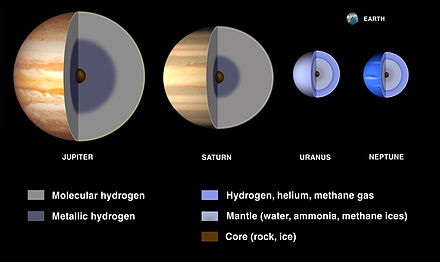|
|
| |
|
|
| |
|
|
|
|
| |
 |
| Cutaways
illustrating models of the interiors of the
giant planets. |
Geochemistry
Geochemistry is the science that uses the tools and
principles of chemistry to explain the mechanisms behind
major geological systems such as the Earth's crust and
its oceans. The realm of geochemistry extends beyond the
Earth, encompassing the entire Solar System, and has
made important contributions to the understanding of a
number of processes including mantle convection, the
formation of planets and the origins of granite and
basalt. It is an integrated field of chemistry and
geology/geography.
History
The term geochemistry was first used by the Swiss-German
chemist Christian Friedrich Schönbein in 1838: "a
comparative geochemistry ought to be launched, before
geochemistry can become geology, and before the mystery
of the genesis of our planets and their inorganic matter
may be revealed." However, for the rest of the century
the more common term was "chemical geology", and there
was little contact between geologists and chemists.
Geochemistry emerged as a separate discipline after
major laboratories were established, starting with the
United States Geological Survey (USGS) in 1884, and
began systematic surveys of the chemistry of rocks and
minerals. The chief USGS chemist, Frank Wigglesworth
Clarke, noted that the elements generally decrease in
abundance as their atomic weights increase, and
summarized the work on elemental abundance in The Data
of Geochemistry. |
|
|
The composition of meteorites was investigated and
compared to terrestrial rocks as early as 1850. In 1901,
Oliver C. Farrington hypothesised that, although there
were differences, the relative abundances should still
be the same. This was the beginnings of the field of
cosmochemistry and has contributed much of what we know
about the formation of the Earth and the Solar System. |
|
|
Geochemistry emerged as a separate discipline after
major laboratories were established, starting with the
United States Geological Survey (USGS) in 1884, and
began systematic surveys of the chemistry of rocks and
minerals. The chief USGS chemist, Frank Wigglesworth
Clarke, noted that the elements generally decrease in
abundance as their atomic weights increase, and
summarized the work on elemental abundance in The Data
of Geochemistry. |
|
|
Some subfields of geochemistry are: |
- Aqueous geochemistry studies the
role of various elements in watersheds, including
copper, sulfur, mercury, and how elemental fluxes are
exchanged through atmospheric-terrestrial-aquatic
interactions.
- Biogeochemistry is the field of
study focusing on the effect of life on the chemistry of
the Earth.
- Cosmochemistry includes the analysis
of the distribution of elements and their isotopes in
the cosmos.
- Isotope geochemistry involves the
determination of the relative and absolute
concentrations of the elements and their isotopes in the
Earth and on Earth's surface.
- Organic geochemistry, the study of
the role of processes and compounds that are derived
from living or once-living organisms.
- Photogeochemistry is the study of
light-induced chemical reactions that occur or may occur
among natural components of the Earth's surface.
- Regional geochemistry includes
applications to environmental, hydrological and mineral
exploration studies.
|
 Wikipedia: Geochemistry Wikipedia: Geochemistry |
|
|
|
|
|
|
|
|
|
|
|
|
|
|
|
|
Search Fun Easy English |
|
|
|
|
|
|
|
|
|
|
|
|
|
|
|
About
Contact
Copyright
Resources
Site Map |